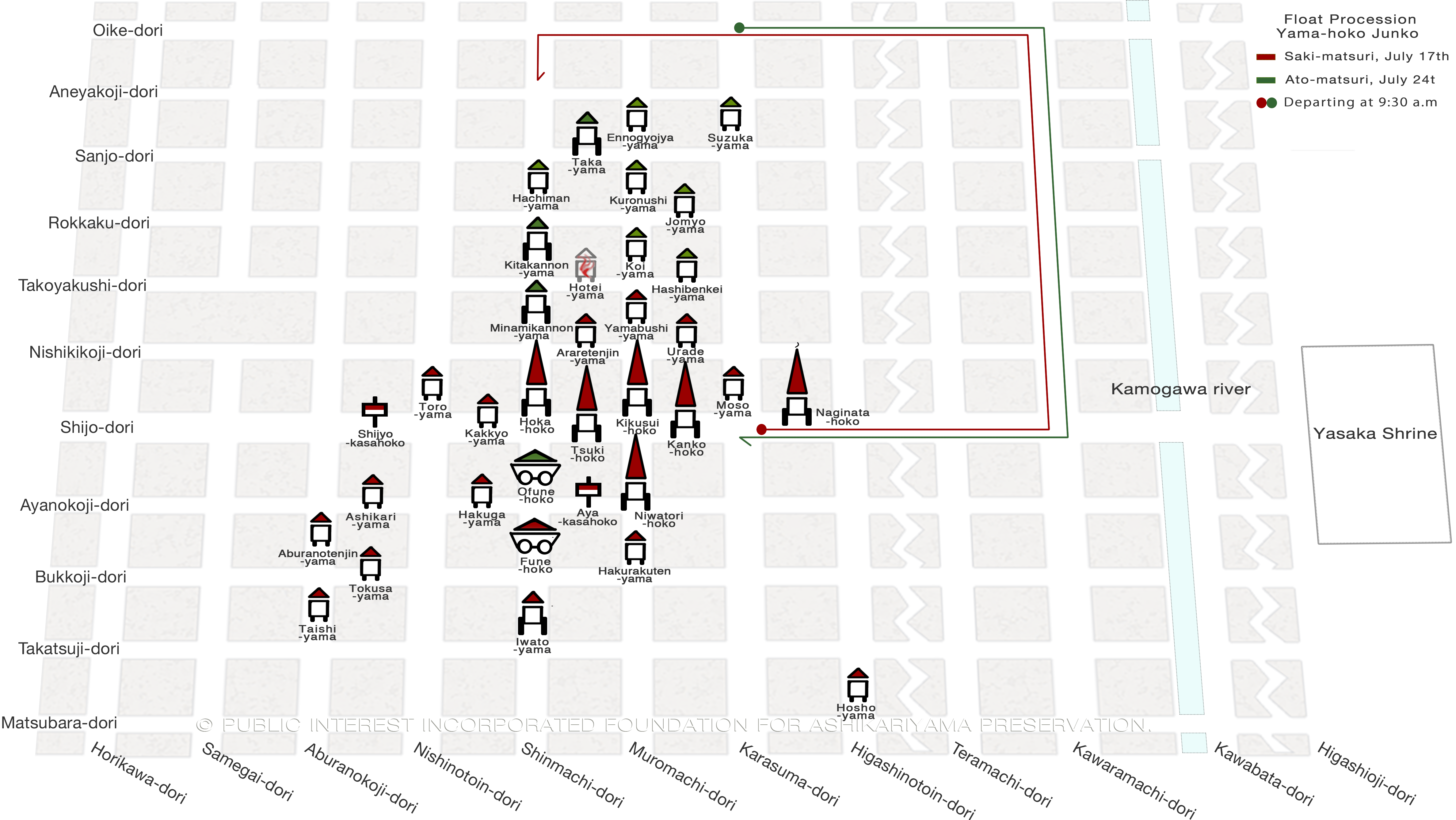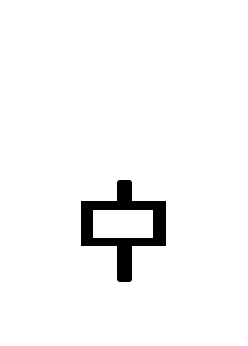GionMatsuri Float Map


Explanation of Floats (Hoko and Yama)
Hoko (Star Floats)
There are five large floats that represent the procession of Gion Matsuri. They are as tall as 25 meters, and travel on large wheels carrying musical accompaniment. A star float is tugged by thirty to forty men on ropes.
FUNE-HOKO (BOAT-SHAPED FLOATS)
These two boat-shaped floats respectively crown the procession in Saki-matsuri and in Ato-matsuri. In 2014, Ofune-hoko for Ato-matsuri was restored for the first time in 150 years. Ancient people called Fune-hoko a “boat of departure” and Ofune-hoko a “boat of return”.Hiki-yama (Towed Floats)
Three floats are classified as hiki-yama (towed floats), which are large for yama and resemble hoko (aka -boko-), in that they have wheels and carry musical accompaniment, though they have pine instead of cypress on top.Kaki-yama (Carried Floats)
Twenty floats are classified as kaki-yama (carried floats), which are carried on shoulders of around twenty men. They are decorated with pine or cedar on top, and hold such divine items as small shrines and divine dolls.Kasa-hoko (Umbrella Floats)
Two floats are classified as kasa-hoko (umbrella floats), which hand down a very old shape of floats. These floats carry an umbrella hanging textile trail, and are accompanied by dancers and musicians.Yake-yama (Burnt Floats)
Floats have been burnt and restored through numerous wars and fires. There are three floats classified as yake-yama (burnt floats), which appear in historical records but do not currently participate in procession, due to destruction by fire or other community reasons.
Location and description of floats
(in alphabetical order)
Sakimatsuri
-

-
Ashikari-yama
- 芦刈山
- West, Nishinotoin-dori and Ayanokoji-dori
- Ashikari-yama is based on the Noh play “Ashikari,” in which a woman finds out her ex-husband, who cuts and sells reed in poverty, and then they get reunited. The Divine Doll’s old clothing is the oldest kosode (a type of kimono) among those for all floats.
-

-
Aburatenjin-yama
- 油天神山
- South, Aburanokoji-dori and Ayanokoji-dori
- A statue of Tenjin (Lord Michizane Sugawara) is enshrined in the portable shrine painted in red.
-

-
Araretenjin-yama
- 霰天神山
- West, Muromachi-dori and Nishikikoji-dori
- This floatenshrines a Tenjin god (Lord Michizane Sugawara), which came down with a hail and extinguished a blaze that nearly devoured Kyoto.
-

-
Ayakasa-hoko
- 綾傘鉾
- West, Muromachi-dori and Ayanokoji-dori
- This float is one of the kasa-hoko (umbrella floats), equipped with a large umbrella, and is accompanied by a dancer twirling a halberd. The dancer wears a red hairy mask, and dances to the bells, drums and flutes.
-

-
Fune-hoko
- 船鉾
- South,Shinmachi-dori and Ayanokoji-dori
- This float is built in the shape of a boat (“Fune”), based on an episode of Jingu Kogo, an ancient empress. A mythical bird is carved at the bow, and a flying dragon at the stern. Charms for safe delivery are handed out.
-

-
Hakuga-yama
- 伯牙山
- West, Shinmachi-dori and Ayanokoji-dori
- This float is based on an anecdote from the Zhou dynasty of China, where a famous koto (an Oriental harp) player severed the strings of his harp upon hearing the news of his friend’s death.
-

-
Hakurakuten-yama
- 白楽天山
- South, Muromachi-dori and Shijo-dori
- This float features a scene from the Tang dynasty of China, in which Hakurakuten, a popular Chinese poet, learns the essence of Buddhism from Master Dorin.
-

-
Hoka-hoko
- 放下鉾
- North, Shinmachi-dori and Shijo-dori
- This float enshrines a monk named“Hokaso”in the center seat. The float top depicts the sun, the moon and stars, shining over the earth.
-

-
Hosho-yama
- 保昌山
- North, Higashinotoin-dori and Matsubara-dori
- This float depicts an ancient warrior who picks up a sprig of red plum blossoms in the Imperial Palace, to present to a celebrated court lady named Izumi Shikibu. Charms for happy marriage are handed out.
-

-
Iwato-yama
- 岩戸山
- South, Shinmachi-dori and Bukkoji-dori
- This float is based on a myth that the sun goddess hid herself behind “Iwato (rock door)”. It enshrines the sun goddess, a man god beside her, and her father god on the roof.
-

-
Kakkyo-yama
- 郭巨山
- East, Nishinotoin-dori and Shijo-dori
- This float is based on the anecdote that Kakkyo, an ancient dutiful Chinese, dug out a gold pot and took great care of his mother.
-

-
Kanko-hoko
- 函谷鉾
- West, Karasuma-dori and Shijo-dori
- This float is based on the anecdote that a famous ancient warrior in China succeeded in disguising his enemy into opening up a steep valley with a pretended rooster cry by one of his men.
-

-
Kikusui-hoko
- 菊水鉾
- North, Muromachi-dori and Shijo-dori
- This float was named after an ancient well that used to be in this place, and bears a large golden chrysanthemum flower at its top. It was restored in 1947 for the first time in 88 years.
-

-
Moso-yama
- 孟宗山
- North, Karasuma-dori and Shijo-dori
- This float is also called "Takenoko-yama". Takenoko is a bamboo shoot, which Moso, an ancient Chinese man, dug out of the snow-covered ground to feed his sick mother.
-

-
Naginata-hoko
- 長刀鉾
- West, Higashinotoin-dori and Shijo-dori
- This float leads the procession every year, and does not participate in the Procession Order Draw. It holds up a halberd (“Naginata”) at its top, which is said to have the power of driving away epidemics and evil spirits. At present, it is the only float in which a live child rides.
-

-
Niwatori-hoko
- 鶏鉾
- South, Muromachi-dori and Shijo-dori
- This float is based on an anecdote from an ancient Chinese dynasty, when the nation was so well ruled that the court drum went out of use and a hen laid eggs on it.
-

-
Shijokasa-hoko
- 四条傘鉾
- West, Nishinotoin-dori and Shijo-dori
- Along with Ayagasa-hoko, Shijokasa-hoko hands down a very old shape of floats.At the top of the umbrella (-kasa-/-gasa-) are attached paper decorations and a pine sapling.The dance accompanying the float was restored in 1988, and is performed by eight children including a halberd bearer.
-

-
Taishi-yama
- 太子山
- South, Aburanokoji-dori and Bukkoji-dori
- This float is based on an episode that Shotoku Taishi, a legendary prince, entered a forest to collect good wood for the construction of the Shitennoji Temple. Charms for wisdom are handed out.
-

-
Tokusa-yama
- 木賊山
- West, Nishinotoin-dori and Bukkoji-dori
- The float depicts a lonesome aged man who cuts scouring rush (tokusa) in Shinano, after having his child kidnapped.
-

-
Toro-yama
- 蟷螂山
- South, Nishinotoin-dori and Shijo-dori
- "Toro" signifies a praying mantis, a doll of which is decorated at the top of this float, interlocked to the wheels, and moves as the float goes. This is the only gimmicked float participating in Gion Matsuri.
-

-
Tsuki-hoko
- 月鉾
- West, Muromachi-dori and Shijo-dori
- This float holds up a crescent ornament at its top, and enshrines the moon god at the center seat. The plant drawing at the back of the float roof was drawn by Okyo Maruyama. Metal ornaments on the pole plates, four pillars etc. are amazing.
-

-
Urade-yama
- 占出山
- East, Muromachi-dori and Nishikikoji-dori
- This float is based on an anecdote of the Empress Jingu, who fished a sweetfish in Hizen (now Nagasaki), and announced that the fish was a sign of victory in the upcoming battle. Amulets for safe delivery are handed out.
-

-
Yamabushi-yama
- 山伏山
- South, Aburanokoji-dori and Bukkoji-dori
- This float features a famous yamabushi (traditional Japanese ascetic), who reportedly recovered the inclination of a temple tower by his mystic power.
Atomatsuri
-

-
Ennogyoja-yama
- 役行者山
- North, Muromachi-dori and Sanjo-dori
- This float depicts a fable that Ennogyoja, the founder of“Shugendo”(Japanese asceticism), who directed a god to build a stone bridge between Mt. Katsuragi and Mt.Omine.
-

-
Hachiman-yama
- 八幡山
- South, Shinmachi-dori and Sanjo-dori
- This float carries a miniature Hachiman Shrine, which was produced in the 18th century.
-

-
Hashibenkei-yama
- 橋弁慶山
- East, Muromachi-dori and Takoyakushi-dori
- This float depicts a well-known battle on the Gojo Bridge in Kyoto, between “Benkei”, a reknowned monk-warrior, and “Ushiwaka-maru”, a popular warrior “Yoshitsune Minamoto” as a youth.
-

-
Jomyo-yama
- 浄妙山
- West, Karasuma-dori and Rokkaku-dori
- This float depicts monk warriors of the Mii Temple, who fought fiercely against the Heike force in the reknowned Ujigawa Battle.
-

-
Kitakannon-yama
- 北観音山
- South, Shinmachi-dori and Rokkaku-dori
- This float has the statues of “Yoryu Kannon (merciful goddess)”and“Idaten (guardian deity)”on it. Pine wood is used for the framework. Metal ornaments are all very gorgeous.
-

-
Koi-yama
- 鯉山
- South, Muromachi-dori and Rokkaku-dori
- This float depicts a Chinese legend that a brave carp that can swim up through to the top of the “Ryumon” waterfall would become a dragon.
-

-
Kuronushi-yama
- 黒主山
- South, Muromachi-dori and Sanjo-dori
- This float depicts“Otomo no Kuronushi”, a popular ancient poet, who looks up at beautiful cherry blossoms.
-

-
Minamikannon-yama
- 南観音山
- North, Shinmachi-dori and Nishikikoji-dori
- This float does not participate in the Procession Order Draw, and is always the last ‘yama’ float in the Atomatsuri procession. It is also called “Kudarikannon”, and enshrines “Yoryu Kannon (merciful goddess)” and an accompanying saint. Willow branches are stuck on the float during procession.
-

-
Taka-yama
- 鷹山
- West, Muromachi-dori and Sanjo-dori
- This is a hiki-yama (towed float) that carries three dolls: a falconer, a hound handler, and a servant who shoulders a barrel and secretly eats chimaki. In 2022, Taka-yama returns to the procession for the first time in 196 years!
-

-
Ofune-hoko
- 大船鉾
- South, Shinmachi-dori and Shijo-dori (Shijo-cho)
- This float does not participate in the Procession Order Draw, and always goes at the very end of the Atomatsuri procession. It was lost in a big fire in 1864, but was restored in 2014 for the first time in 150 years.
-

-
Suzuka-yama
- 鈴鹿山
- North, Karasuma-dori and Sanjo-dori
- This float enshrines Goddess Suzuka, who defeated a demon that agonized people near Mt.Suzuka in Ise (present Mie Prefecture).